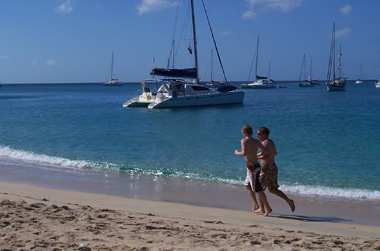Somewhere out there exists the real Caribbean—a hidden land pleasantly lacking foreign-owned, all-inclusive resorts that gate guests in and keep the island out.
On this island, expats, sailors, guests and locals merge into a unique camaraderie shared over cold beers while being serenaded by the rhythms of reggae and steel drums. One falls asleep to the cry of the neighbor's pet goat and wakes up to the alarm of the resident rooster.
This secret land, although hard to get to, is well worth a visit. To meet the real Caribbean face to face, one must get to Bequia (pronounced 'bekway'), the crown jewel of St. Vincent and the Grenadines.
The island, only nine miles south of St. Vincent (known as the "Mainland" to locals), was first settled by the Arwak people. They were displaced by the Caribs, a warlike race who took over the island and named it "Becouya" or "Island of Clouds."The long period of European colonization began in 1664 when the French claimed Bequia. Between 1763 and 1783, the English and French flip-flopped control of the Grenadine islands until the Treaty of Versailles gave ultimate control to England.
Under English rule, agriculture, particularly sugar, was promoted throughout the island. When the sugar trade declined, the people of Bequia turned to the sea and began a culture of fishing, whaling and boat building. The whaling industry attracted Scots, and even today their influence is felt. Because whaling is considered an indigenous tradition, the country is allowed to catch two whales per year under international treaty.
In 1979 St. Vincent and the Grenadines attained independence but remained part of the British Commonwealth. Due to its off-the-beaten-path location, Bequia, and the country as a whole, have focused on local, authentically Caribbean tourism that appeals to yachters and adventure travelers. In a large part, the lack of mass tourism is a result of the policies of beloved Prime Minister J.F. Mitchell, who once said: "The tourist dollar alone, unrestricted, is not worth the devastation of my people. A country where people have lost their soul is no longer worth visiting. We will encourage only small numbers of visitors whose idea of a holiday is not heaven or paradise, but participation in a different experience. We shall try to avoid the fate of some of our Caribbean neighbors who have ridden the tiger of tourism only to wind up being devoured by it. Large super-luxury hotels with imported management, materials, and values bring false prosperity with the negative side effects of soaring land prices that kill agriculture, polluted beaches, traffic jams, high-rise construction that ravages hillsides and scalds the eyeballs—the very problems that the visitors want to forget."
Although Bequia's tropical climate makes it an ideal year-round destination, the best time to go is during the dry months. The dry season runs from approximately January to May and the rainy season from June through December, with July being the wettest. From September to November hurricanes are always a potentially dangerous occurrence.
Being only seven square miles in size, the entire island can be taken in with a leisurely stroll.Other options include dollar buses, taxis (pick-up trucks with canvas awnings over the cabs) and water taxis for beach hopping. Taxis can be picked up at The Almond Tree in central Port Elizabeth, which is literally just an almond tree where the drivers sit in the shade and wait for business. Fares should be negotiated prior to the trip.
Bequia is not a destination full of marquee attractions, since the real attraction here is its laid-back local character. A popular answer to the question of "What's there to do?" is a simple: "Nothing." Which is exactly the beauty of the island. Be sure to pack lots of paperbacks, crosswords and playing cards.
Bequia's mountainous terrain blesses it with several secluded harbors lined with long stretches of peaceful sands. All beaches are public, but you'll rarely see more than a handful of people at any given time. "
Nicholas J. Klenske is a freelance writer and practicing attorney. He is based somewhere in the cornfields of Iowa, where, at last count, the pigs greatly outnumbered the people. To read more of his adventures, go to gonomad.com, where this story originally appeared.



